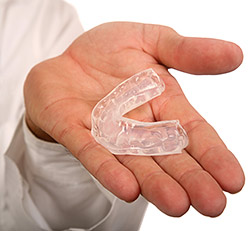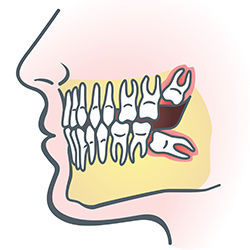Topics on this page

Regular Exams and Cleanings
Regular exams are an essential part of maintaining your child’s oral health. During your youngster’s regular exam, we will:
- Check for any problems that may not be seen or felt
- Look for cavities or other signs of tooth decay
- Inspect the teeth and gums for inflammation, commonly known as gingivitis
- Perform a thorough teeth cleaning
Depending on your little one’s age, the exam can take up to about 30 minutes. Each regular exam includes a detailed teeth cleaning, during which we will clean, polish, and rinse the teeth to remove any tartar and plaque that have built up on the tooth’s surface.
Visiting our office every six months gives you the chance to ask Dr. Parker any questions you may have about your child’s oral health. Regular exams are offered by appointment only, so please contact our practice today to schedule your son or daughter’s next dental exam and teeth cleaning.
Bonding
 Bonding is a conservative way to repair slightly chipped, discolored, or crooked teeth. During dental bonding, a white filling is placed onto your child's tooth to improve its appearance.
Bonding is a conservative way to repair slightly chipped, discolored, or crooked teeth. During dental bonding, a white filling is placed onto your child's tooth to improve its appearance.
The filling “bonds” with the tooth. Because it comes in a variety of tooth-colored shades, it closely matches the appearance of your child’s natural teeth.
Tooth bonding can also be used for fillings instead of amalgam. Many patients prefer bonded fillings because the white color is much less noticeable than silver. Bonding fillings can be used on front or back teeth, depending on the location and extent of tooth decay.
Bonding is less expensive than other cosmetic treatments and can usually be completed in one visit to our office. However, it also can stain and is easier to break than other cosmetic treatments, such as porcelain veneers. If it does break or chip, let us know. The bonding can generally be easily patched or repaired in one visit.
Crowns
 Crowns are a restorative procedure used to improve a tooth’s shape or to strengthen it. Crowns are most often used for teeth that are broken, worn, or have portions destroyed by tooth decay.
Crowns are a restorative procedure used to improve a tooth’s shape or to strengthen it. Crowns are most often used for teeth that are broken, worn, or have portions destroyed by tooth decay.
A crown is a “cap” cemented onto an existing tooth that usually covers the portion of the tooth above the gum line. In effect, the crown becomes the tooth’s new outer surface.
Crowns can be made of porcelain, metal, or both. Stainless steel crowns are used most often in pediatric dentistry because they provide a more customizable fit and are a dependable material that causes minimal soft-tissue irritation.
Extractions
 There are times when it is necessary to remove a tooth. Sometimes a baby tooth has misshapen or long roots that prevent it from falling out as it should, and the tooth must be removed to make way for the permanent tooth to erupt.
There are times when it is necessary to remove a tooth. Sometimes a baby tooth has misshapen or long roots that prevent it from falling out as it should, and the tooth must be removed to make way for the permanent tooth to erupt.
At other times, a tooth may have so much decay that it puts the surrounding teeth at risk, so a doctor may recommend its removal. Infection, orthodontic correction, or problems with a wisdom tooth can also require removal of a tooth.
When it is determined that a tooth needs to be removed, Dr. Parker may extract it during a regular checkup or request another visit for this procedure. The root of each tooth is encased within the jawbone in a “tooth socket,” and the tooth is held in that socket by a ligament.
In order to extract a tooth, the dentist must expand the socket and separate the tooth from the ligament that holds it in place. Though this procedure is typically very quick, it is critical to share with us any concerns or preferences for sedation.
Fillings
 Traditional dental restoratives, or fillings, may include composite or amalgam. Composite resin materials are used most commonly because today because they mimic the appearance of natural teeth.
Traditional dental restoratives, or fillings, may include composite or amalgam. Composite resin materials are used most commonly because today because they mimic the appearance of natural teeth.
Fluoride
 Fluoride is effective in preventing cavities and tooth decay. It also prevents plaque from building up and hardening on the tooth’s surface. A fluoride treatment in our office takes just a few minutes.
Fluoride is effective in preventing cavities and tooth decay. It also prevents plaque from building up and hardening on the tooth’s surface. A fluoride treatment in our office takes just a few minutes.
After the treatment, your child may be asked not to rinse, eat, or drink for at least 30 minutes in order to allow the teeth to absorb the fluoride. Depending on your child’s oral health or the doctor’s recommendation, a fluoride treatment may be required every three, six, or 12 months.
Mouthguards
 Whether your child wears braces or not, protecting his or her smile while playing sports is essential. Mouthguards help protect the teeth and gums from injury. If your child participates in any kind of full-contact sport, the American Dental Association recommends that he or she wear a mouthguard.
Whether your child wears braces or not, protecting his or her smile while playing sports is essential. Mouthguards help protect the teeth and gums from injury. If your child participates in any kind of full-contact sport, the American Dental Association recommends that he or she wear a mouthguard.
Choosing the right mouthguard is essential. There are three basic types of mouthguards: the pre-made mouthguard, the “boil-and-bite” fitted mouthguard, and a custom-made mouthguard from a dentist. When you choose a mouthguard, be sure to pick one that is tear-resistant, comfortable and well-fitted for the mouth, easy to keep clean, and does not prevent your child from breathing properly.
We can show your athlete how to wear a mouthguard properly and how to choose the right mouthguard to protect his or her smile.
Nightguards
 If your child often wakes up with jaw pain, earaches, or headaches, or you see him or her clenching or grinding teeth, your child may have a common condition called “bruxism.” Many people do not even know that they grind their teeth, since it often occurs when one is sleeping. If not corrected, bruxism can lead to broken teeth, cracked teeth, or even tooth loss.
If your child often wakes up with jaw pain, earaches, or headaches, or you see him or her clenching or grinding teeth, your child may have a common condition called “bruxism.” Many people do not even know that they grind their teeth, since it often occurs when one is sleeping. If not corrected, bruxism can lead to broken teeth, cracked teeth, or even tooth loss.
There is an easy, non-invasive treatment for bruxism. Nightguards are an easy way to prevent the wear and damage that teeth-grinding causes over time. Custom-made by a dentist from soft material to fit the teeth, a nightguard is inserted over your child’s top or bottom arch and prevents contact with the opposing teeth.
Sealants
 Sometimes brushing is not enough, especially when it comes to those hard-to-reach spots in your child’s mouth. It is difficult for a toothbrush to get between the small cracks and grooves on your child’s teeth.
Sometimes brushing is not enough, especially when it comes to those hard-to-reach spots in your child’s mouth. It is difficult for a toothbrush to get between the small cracks and grooves on your child’s teeth.
If left alone, those tiny areas can develop tooth decay. Sealants give your child’s teeth extra protection against decay and help prevent cavities.
Dental sealants are a plastic resin that bonds and hardens in the deep grooves on your youngster’s tooth’s surface. When a tooth is sealed, the tiny grooves become smooth and are less likely to harbor plaque. With sealants, brushing your child’s teeth becomes easier and more effective against tooth decay.
Sealants are typically applied to children’s teeth as a preventive measure against tooth decay after the permanent teeth have erupted. It is more common to seal “permanent” teeth rather than “baby” teeth, but every patient has unique needs, and Dr. Parker will recommend sealants on a case-by-case basis.
Sealants last from three to five years, but it is fairly common to see adults with sealants still intact from their childhood. A dental sealant only provides protection when it is fully intact, so if your child’s sealants come off, let us know, and schedule an appointment for your son or daughter’s teeth to be re-sealed.
Wisdom Teeth
 Wisdom teeth are molars found in the very back of your child’s mouth. These teeth usually appear in late teens or early 20s, but they may become impacted (fail to erupt) due to lack of room in the jaw or angle of entry.
Wisdom teeth are molars found in the very back of your child’s mouth. These teeth usually appear in late teens or early 20s, but they may become impacted (fail to erupt) due to lack of room in the jaw or angle of entry.
When a wisdom tooth is impacted, it may need to be removed. If it is not removed, your child may develop gum tenderness, swelling, or even severe pain. Impacted wisdom teeth that are partially or fully erupted tend to be quite difficult to clean and are susceptible to tooth decay, recurring infections, and even gum disease.
Wisdom teeth are typically removed in the late teens or early twenties because there is a greater chance the roots have not fully formed and the bone surrounding the teeth is less dense. These two factors can make extraction easier as well as shorten the recovery time.
In order to remove a wisdom tooth, Dr. Parker first needs to numb the area around it with a local anesthetic. Since the impacted tooth may still be under the gums and embedded in the jaw bone, Dr. Parker will need to remove a portion of the covering bone to extract the tooth.
In order to minimize the amount of bone that is removed with the tooth, the doctor will often “section” the wisdom tooth so each piece can be removed through a small opening in the bone.
Once your child’s wisdom teeth have been extracted, the healing process begins. Depending on the degree of difficulty related to the extraction, healing time varies. We will share with you what to expect and provide instructions for a comfortable, efficient healing process.
